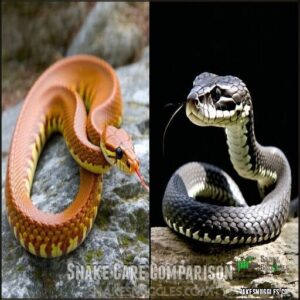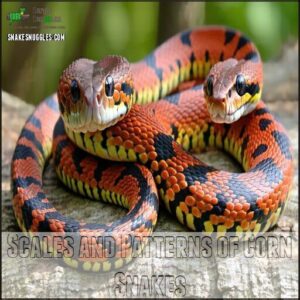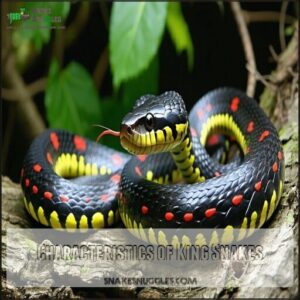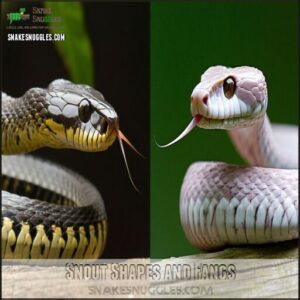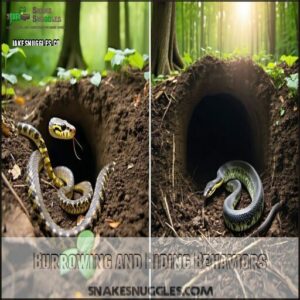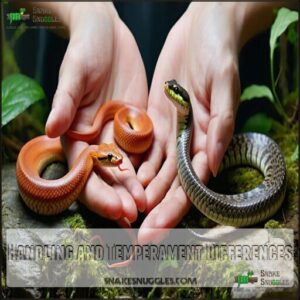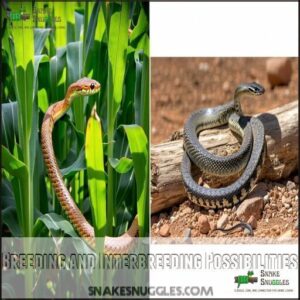This site is supported by our readers. We may earn a commission, at no cost to you, if you purchase through links.
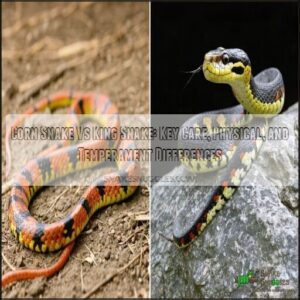
Corn snakes typically have slender bodies with reddish-orange coloration and black-bordered patches, while kingsnakes display bold bands of black, red, and yellow (or other color variations).
Kingsnakes can grow slightly larger, reaching 3-5 feet compared to corn snakes’ 2-4 feet.
Though both make excellent pets, corn snakes tend to be more docile and less likely to bite, making them ideal for beginners.
Kingsnakes are known for their hardier nature and impressive feeding response—they’ll even eat other snakes in the wild.
The right choice often comes down to handling preferences and your comfort with feeding habits.
Table Of Contents
- Key Takeaways
- Snake Care Comparison
- Identifying Key Physical Differences
- Size, Habitat, and Hunting Methods
- Handling and Temperament Differences
- Breeding and Interbreeding Possibilities
- Frequently Asked Questions (FAQs)
- What is the difference between a corn snake and a king snake?
- How to tell a king snake from a Rat Snake?
- Can kingsnakes breed with corn snakes?
- What snake is mistaken for a corn snake?
- How to tell a king snake from a rat snake?
- Can kingsnakes breed with Corn snakes?
- Is a corn snake the same as a rat snake?
- What’s the difference between a king snake and a rat snake?
- What is the difference between a king snake and a corn snake?
- How do you tell if a snake is a corn snake?
- Conclusion
Key Takeaways
- You’ll find corn snakes have slender bodies with reddish-orange coloration and black-bordered patches, while kingsnakes display bold bands of black, red, and yellow with more varied patterns.
- While both make excellent pets, corn snakes tend to be more docile and beginner-friendly, whereas kingsnakes have stronger feeding responses and may be more challenging to handle.
- You’ll need different care setups – corn snakes prefer moderate humidity (40-50%) with 85-88°F basking temps, while kingsnakes require slightly higher humidity (50-60%) and warmer basking areas (88-92°F).
- Despite their different genera (Pantherophis for corn snakes, Lampropeltis for kingsnakes), both species require secure enclosures to prevent escapes, regular handling to maintain temperament, and frozen-thawed prey for safety.
Snake Care Comparison
You’ll need to understand key care differences between corn snakes and kingsnakes before bringing one home.
Both species require specific housing, dietary needs, and temperature conditions that affect their health and happiness.
Housing and Substrate Differences
Your snake’s home sets the foundation for their health and happiness. Both corn snakes and kingsnakes thrive in similar enclosures, though with some key differences.
A cozy, secure enclosure isn’t just a cage—it’s your snake’s sanctuary and the key to their wellbeing.
| Feature | Corn Snake | Kingsnake |
|---|---|---|
| Enclosure Size | 20-40 gallon minimum | 20-40 gallon, slightly larger preferred |
| Substrate Types | Aspen shavings, paper | Aspen, coconut fiber |
| Humidity Needs | 40-50% | 50-60% |
| Hiding Spots | 2-3 hides minimum | Multiple hides required |
Always secure your tank tightly—these escape artists can squeeze through tiny gaps! Both species need proper ventilation through mesh lids. A proper corn snake habitat is vital for their well-being.
Weekly cleaning prevents bacterial growth. "I tell new owners to think of substrate as your snake’s mattress—they’ll spend most of their time on it, so choose wisely," says one experienced keeper, emphasizing the importance of a good environment for the snakes.
Dietary Requirements and Feeding Habits
Feeding your snake properly is straightforward once you understand the basics. In their wild diet, corn snakes focus mainly on rodents while kingsnakes, with their venom immunity, eat a more varied diet including other snakes.
A vital aspect involves temperature gradient maintenance to facilitate proper digestion and overall health.
| Feature | Corn Snake | Kingsnake |
|---|---|---|
| Prey Size | 1-1.5x body width | 1-1.5x body width |
| Feeding Frequency | Hatchlings: 5-7 days |
Adults: 14 days
Adults: 7 days
Always use frozen-thawed prey rather than live for safety. Kingsnakes are enthusiastic eaters with strong feeding responses, so keep your fingers clear during mealtime! They have a varied diet and are known for their strong feeding responses.
Temperature and General Care Variations
The right temperature setup makes all the difference in snake care.
Both corn snakes and kingsnakes need specific environments to thrive.
| Feature | Corn Snake Care | Kingsnake Care |
|---|---|---|
| Basking Temp | 85-88°F | 88-92°F |
| Humidity | 40-50% | 50-60% |
| Enclosure Size | 20+ gallons | 30+ gallons |
| Substrate | Aspen or paper | Coconut fiber or cypress |
| Lighting | Low UVB optional | Low UVB recommended |
Corn snakes prefer moderate humidity with simple ground-level hides, while kingsnakes are explorers that tolerate slightly higher humidity levels.
Always include a cool zone (75-80°F) to let your snake regulate its body temperature. A vital aspect is maintaining a proper heat gradient within the enclosure.
Remember: proper ventilation prevents moisture buildup, and secure enclosures keep these escape artists where they belong!
Identifying Key Physical Differences
You’ll notice distinct differences between corn snakes and kingsnakes when you examine their scales, patterns, and head shapes.
Corn snakes typically display orange or red coloration with black markings and slightly upturned snouts, while kingsnakes show bold bands of black, yellow, and red with blunter, rounded snouts.
Scales and Patterns of Corn Snakes
When you look at corn snakes up close, you’ll notice their incredibly smooth scales that feel almost silk-like to the touch.
Their marbled appearance features striking color morphs ranging from vibrant reds and oranges to subtle greys and yellows.
Unlike other species, corn snakes display a distinctive checkered pattern on their bellies that resembles a checkerboard.
Each snake’s pattern uniqueness comes from specific genetics, making no two corn snakes exactly alike. Their red coloration often appears alongside black borders, creating that classic corn snake look collectors prize.
Scale smoothness is a defining characteristic you’ll immediately notice. Some breeders focus on the Okeetee locality for its striking red saddle markings.
Characteristics of King Snakes
While corn snakes charm with subtle beauty, king snakes command attention with their bold appearance. These remarkable reptiles display striking bands of black, yellow, and red that cleverly mimic venomous species—a natural defense mechanism that works wonderfully.
The wild beauty of kingsnakes isn’t just for show—their bold bands serve as nature’s perfect warning sign to predators.
King snake characteristics include:
- Smooth, glossy scales that catch the light and showcase their vibrant patterns
- Various kingsnake subspecies featuring unique color combinations and pattern variations
- Impressive venom immunity that allows them to prey on other snakes
With over 45 different kingsnake subspecies, you’ll find incredible diversity in their appearance. Their distinctive banded patterns aren’t just beautiful—they’re functional warning signals that keep predators away, showcasing their natural defense mechanism and distinctive banded patterns.
Snout Shapes and Fangs
Beyond their colorful patterns, snakes can be identified by their unique head shapes.
When comparing snout morphology, you’ll notice corn snakes feature slightly tapered, rounded snouts perfect for burrowing, while kingsnakes have sharper, narrower profiles for pursuing prey in tight spaces.
Both species lack venomous fangs but possess small, curved teeth designed for gripping.
Their bite differences reflect their hunting strategies – corn snakes for small rodents, kingsnakes for diverse prey including other snakes, which is a result of their unique hunting strategies.
Size, Habitat, and Hunting Methods
You’ll notice major differences between corn snakes and kingsnakes in how they grow, where they live, and how they hunt their prey.
While corn snakes typically reach 3-5 feet with a leaner build, kingsnakes can grow up to 6 feet and pack more weight, making their size difference something to keep in mind when choosing your perfect reptilian companion, considering their distinct physical characteristics, such as weight.
Length and Weight Variations
Comparing sizes reveals striking differences between these popular pet snakes:
- Growth Rate: Corn snakes reach 3-5 feet with a sleek build, while kingsnakes grow to 6+ feet with a heavier frame.
- Average Weight: Corn snakes typically max out at 2.5 pounds, but kingsnakes can reach 4 pounds.
- Captive Size: Both species tend to be smaller in captivity than their wild counterparts.
These length and weight variations affect enclosure needs and handling techniques.
Their locomotion relies on serpentine movement for efficient slithering.
Forest or Wooded Area Preferences
The natural environment shapes both corn snakes and kingsnakes’ habits in distinct ways.
You’ll find corn snakes thriving in pine forests with scattered logs and leaf litter, while kingsnakes prefer mixed woodlands with dense undergrowth.
These reptiles share habitat overlap in southeastern oak groves, though each has adapted different survival techniques.
Corn snake habitat often extends to suburban edges where they hunt rodents, while kingsnake habitat includes rocky outcroppings and hollow logs.
Both species utilize burrowing techniques for protection, but they’ve evolved separate preferences within forest ecosystems that reflect their hunting styles and safety needs.
The natural environment plays a crucial role in shaping these preferences, and understanding these differences is key to appreciating the unique characteristics of each species, including their ability to thrive in southeastern oak groves.
Burrowing and Hiding Behaviors
While woodland areas provide the perfect backdrop for both species, their underground behavior offers fascinating insights into their survival strategies.
Unlike their tree-dwelling cousins, corn snakes and kingsnakes show remarkable burrowing abilities:
- Corn snakes prefer natural substrates like loose soil and leaf litter, using these materials to create shallow burrows for daytime rest.
- Kingsnakes display more aggressive digging, often creating deeper tunnels for habitat security and nocturnal activity.
- Both species utilize existing mammal burrows as ready-made hideaways, demonstrating clever adaptation rather than expending energy on new construction.
When setting up enclosure enrichment, you’ll want to mimic these natural behaviors for healthier, happier snakes. Providing the right burrowing material is essential for their well-being.
Handling and Temperament Differences
You’ll notice clear differences in handling these two popular pet snakes, with corn snakes typically showing a more docile nature that rarely results in stress-induced biting.
Kingsnakes, while also manageable for owners, often display more explorative and occasionally feisty behaviors, making them slightly more challenging for complete beginners to handle confidently.
Corn Snakes’ Calm Nature
Corn snakes stand out in the reptile world for their remarkably docile nature.
If you’re considering beginner reptiles, these gentle creatures should top your list.
Unlike their kingsnake cousins, corn snakes rarely bite even when startled, making them ideal family pets.
You’ll find handling your corn snake becomes easier with each interaction as they grow accustomed to your touch.
Most owners report that their corn snake temperament remains consistently calm, requiring minimal stress reduction techniques during handling.
This docile snake vs the more defensive kingsnake means you’ll spend less time worrying about bite risk and more time enjoying your pet, thanks to their gentle behavior.
King Snakes’ Active and Constricting Behavior
Unlike corn snakes, kingsnakes display remarkably active hunting behavior with impressive constriction strength.
Your kingsnake will actively seek prey through scent, then use powerful muscles to subdue it.
When hunting, kingsnakes typically:
- Track prey using their excellent sense of smell
- Strike with surprising speed and accuracy
- Coil tightly around prey, restricting blood flow until it stops moving
This natural hunting instinct makes kingsnakes more alert and responsive than corn snakes, affecting their overall temperament during handling sessions, which can be considered their natural behavior.
Implications for Snake Owners
Moving from behaviors to practical advice, understanding your snake’s temperament directly affects your pet ownership experience.
The docile nature of corn snakes versus the more active kingsnakes means different handling approaches.
For successful snake ownership:
- Match to your experience level – Corn snakes offer better beginner friendliness with lower bite risk
- Secure enclosures properly – Both snakes are escape artists, but kingsnakes are especially determined
- Establish handling routines – Regular, gentle handling helps with temperament training
- Respect natural behaviors – A kingsnake’s assertiveness isn’t personal, while a corn snake’s calmness isn’t boring
Breeding and Interbreeding Possibilities
You’ll find that breeding practices differ substantially between corn snakes and kingsnakes, with successful interbreeding between these distinct species being extremely rare.
While both snakes belong to different genetic families – corn snakes related to rat snakes and kingsnakes to milk snakes – understanding their reproductive incompatibilities can help you make informed decisions about your breeding projects.
Can King Snakes Breed With Corn Snakes?
Yes, king snakes can interbreed with corn snakes despite belonging to different genera.
These hybrids, often called "corn kings," are possible due to genetic compatibility between the species.
However, successful hybridization is rare and faces significant breeding barriers.
While viable offspring can result from these pairings, many breeders avoid this practice for ethical reasons.
Natural evolutionary implications suggest these species don’t typically hybridize in the wild.
Implications of Hybridization
Beyond the question of possibility, hybrid breeding between corn snakes and kingsnakes raises important considerations about consequences.
When these distinct species interbreed, the resulting hybrid offspring carry genetic material from both parents.
While this might sound fascinating, there are several implications to examine:
- Health Concerns – Hybrids may inherit neurological issues like the "stargazer" condition or develop unpredictable immune responses not seen in either parent species.
- Conservation Impact – Creating hybrids potentially dilutes the genetic diversity of pure populations, threatening the distinct characteristics that make each species unique.
- Ethical Considerations – Breeding for novel aesthetics raises questions about prioritizing appearance over animal welfare, especially when hybrids might face health challenges.
Successful hybridization isn’t just rare—it comes with responsibility.
Understanding snake breeding genetics is essential for responsible practices.
While viable offspring are possible, the long-term effects on snake genetics remain poorly understood.
Rarity and Difficulty of Successful Breeding
While hybridization might sound fascinating, successful breeding between corn snakes and kingsnakes remains exceptionally challenging in practice.
The reproductive timelines of these species differ substantially. Corn snakes typically mature at 18-24 months, while kingsnakes reach breeding age much earlier—males at just 9 months and females around 18 months.
This timing mismatch creates natural barriers to successful crossbreeding. Clutch size varies too, with corn snakes producing 10-30 eggs compared to kingsnakes’ 3-24 eggs.
However, the real breeding challenges aren’t about quantity but genetic compatibility. If you’re interested in snake breeding, focusing on single-species corn snake morphs or kingsnake morphs reduces genetic risks and increases incubation success.
Frequently Asked Questions (FAQs)
What is the difference between a corn snake and a king snake?
Corn snakes are docile with red-orange coloration, while kingsnakes are more aggressive with bold bands.
You’ll notice corn snakes have slender snouts and are easier to handle, but kingsnakes grow larger and live longer.
How to tell a king snake from a Rat Snake?
You’d think telling these look-alikes apart would be impossible!
Check the pattern: king snakes have smooth scales with bands that encircle the body, while rat snakes have keeled scales with blotchy patterns.
Can kingsnakes breed with corn snakes?
No, kingsnakes and corn snakes can’t breed together.
They belong to different genera (Lampropeltis vs. Pantherophis), making them genetically incompatible.
You won’t find natural hybrids between these two popular pet species.
What snake is mistaken for a corn snake?
Ever mistaken identities?
Prairie kingsnakes are commonly confused with corn snakes due to their similar patterns.
You’ll also find some milk snakes and rat snakes looking remarkably like corn snakes in the wild.
How to tell a king snake from a rat snake?
You’ll spot king snakes by their vibrant bands (often black, red, and yellow) and blunt snouts,
while rat snakes have less distinct patterns and slightly upturned snouts with more elongated bodies.
Can kingsnakes breed with Corn snakes?
No, kingsnakes and corn snakes can’t breed together.
They’re from different genera – Lampropeltis for kingsnakes and Pantherophis for corn snakes.
You won’t find hybrid offspring between these two distinct snake species.
Is a corn snake the same as a rat snake?
Corn snakes were previously classified as rat snakes, belonging to the same scientific family.
They’re closely related but not identical.
You’ll find corn snakes are actually a specific type of rat snake with distinct markings.
What’s the difference between a king snake and a rat snake?
Remarkable reptiles reveal real distinctions.
Kingsnakes are known for their banded patterns and can eat other snakes, while rat snakes have blotchy markings and are excellent climbers.
Both make good pets with proper care.
What is the difference between a king snake and a corn snake?
You’ll find that kingsnakes are more aggressive with bold black, yellow, and red bands, while corn snakes are docile with orange-red coloration.
Kingsnakes can grow larger (up to 7 feet) than corn snakes (3-6 feet), which is a notable difference in their size.
How do you tell if a snake is a corn snake?
You’ll recognize a corn snake by its reddish-orange body with black-bordered rectangular marks, slender build, and slightly upturned snout.
They’re also typically docile when handled and have smooth scales with checkered bellies.
Conclusion
While kingsnakes display bold bands and aggressive feeding habits, corn snakes offer gentle temperaments with vibrant patterns.
You’ll find both make rewarding pets, but your choice depends on your experience level and preferences.
Corn snake vs kingsnake considerations should include housing needs, temperature requirements, and your comfort with handling.
Whether you choose the docile corn snake or the more assertive kingsnake, you’re investing in a fascinating companion that will thrive with proper care for up to 20 years.

